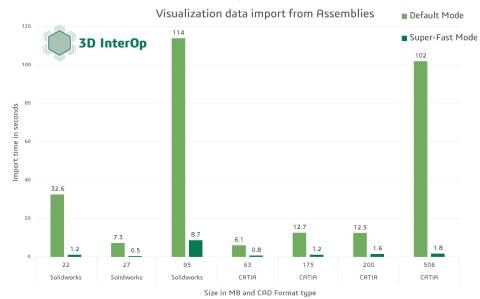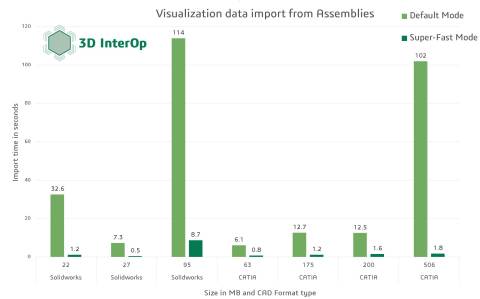BROOMFIELD, Colo.--(BUSINESS WIRE)--Spatial Corp, the leading provider of 3D software development toolkits for design, manufacturing, and engineering solutions, and a subsidiary of Dassault Systèmes, announces today the production release of 2020 1.0.1, which delivers new functionality to enable hybrid manufacturing capabilities for CGM modeling solutions. In addition, this release delivers improved robustness for simulation workflows for both CGM Core Modeler and 3D ACIS Modeler, as well as enhanced application responsiveness during import operations.
New Hybrid Manufacturing Support
Building on the hybrid modeling capabilities delivered by the combination of CGM Core Modeler and CGM Polyhedra, this release delivers two new operators to support hybrid manufacturing workflows:
- Wall thickness analysis
- Rolling ball offset
These two operators can work on CAD BRep data or tessellated models produced by scanning a 3D object. Modeling data can now be prepared for 3D printing by leveraging wall thickness analysis and offset operators to produce lightweight, yet printable parts.
Faster Selective Import for Optimal Performance
Enable your application to quickly review a large CAD assembly, isolate and import exact B-rep data for just a select number of parts and then continue the engineering workflow without having to re-start the import process.
This release builds on the selective import capabilities of 3D InterOp by greatly improving import performance, for example, allowing an application to import only the data needed to visualize a large CAD model within a few seconds. These improvements affect the import of files from Dassault Systèmes’ CATIA and SOLIDWORKS applications.
By allowing the application to continue importing B-rep data in the background, user productivity and application responsiveness are greatly enhanced.
Improved Robustness for Simulation Workflows
This release of CGM Core Modeler delivers enhanced robustness for non-regularized unite operation on exact geometry. End users will now experience better interface generation and identification between different bodies in a CAD model, thus allowing for automation in data preparation for simulation workflows, such as heat transfer, structural dynamics and computational fluid dynamics.
More Robust Boolean Operations
For the 3D ACIS Modeler, this release delivers more robust incremental Boolean operations, delivering a more consistent success rate when dealing with complex and noisy datasets. ACIS-based simulation applications performing multi-body Boolean operations will especially benefit from this new release.
Customer-Driven Improvements to 3D ACIS Modeler
The Spatial business model is a collaborative one, engaging with clients as partners rather than just customers. The result of such tight collaboration is feedback for new and improved features. The release delivers on this feedback with the following enhancements for 3D ACIS Modeler:
- Up to 65% improvement in performance when wrapping a large number of wire bodies on a face through multi-threading processing, enabling real-time marking, engraving or etching of 3D objects.
- The ability to generate line and arc segments from co-planar point segments, enabling an application to convert scanned data to B-Rep or exact geometry for downstream editing and processing.
Other Release Highlights
This release also delivers a number of other improvements for various Spatial components.
3D InterOp
- Import of CATIA V5 threads data is now supported for all three modeler flavors of 3D InterOp.
-
Updated CAD version support:
- CATIA V5-6 R2020
- NX 1872 and 1899
- Parasolid 32.0.152
- JT 10.3 & 10.5
- Revit 2019
- PMI from SOLIDWORKS 2020
CGM Core Modeler
New hybrid operators to perform splits, intersections, disconnect a group of wires, extract boundaries, create silhouette, etc. on both exact B-Rep as well as polyhedral models.
3D ACIS Modeler
- ACIS-HOOPS Bridge updated to support HOOPS Visualize 3DF API v24.10 on all platforms
- Added the capability to generate miter faces when thickening connected sheets to create manufacturable parts
- Improved prevention of zero-length edge generation
About Spatial Corp
Spatial Corp, a Dassault Systèmes subsidiary, is the leading provider of 3D software development toolkits for technical applications across a broad range of industries. Spatial 3D modeling, 3D visualization, and CAD translation software development toolkits help application developers deliver market-leading products, maintain focus on core competencies, and reduce time-to-market. For over 30 years, Spatial’s 3D software development toolkits have been adopted by many of the world's most recognized software developers, manufacturers, research institutes, and universities. Headquartered in Broomfield, Colorado, Spatial has offices in the USA, Germany, Japan, China, and the United Kingdom. For more information, visit www.spatial.com.



